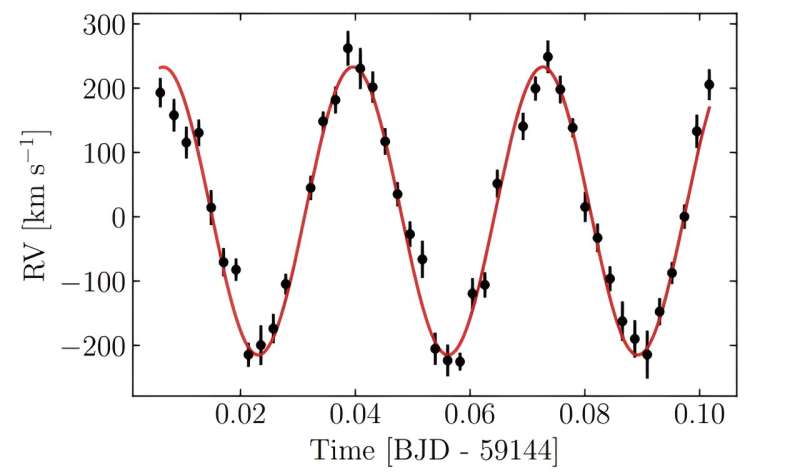August 9, 2023 report
This article has been reviewed according to Science X's editorial process and policies. Editors have highlighted the following attributes while ensuring the content's credibility:
fact-checked
preprint
trusted source
proofread
Astronomers detect an eclipsing double white dwarf binary

An international team of astronomers has observed a distant white dwarf known as WDJ 022558.21−692025.38. It turns out that the observed object is an eclipsing double white dwarf binary system. The finding is reported in a paper published July 31 on the preprint server arXiv.
White dwarfs (WDs) are stellar cores left behind after a star has exhausted its nuclear fuel. Due to their high gravity, they are known to have atmospheres of either pure hydrogen or pure helium. However, a small fraction of WDs show traces of heavier elements.
Astronomers are interested in finding and studying double white dwarfs (DWDs), as their mergers are believed to produce new white dwarfs with higher masses. It is assumed that some high-mass white dwarfs in the solar neighborhood could be DWD merger products. However, although the galactic population of DWDs is estimated to be in the hundreds of millions, only a small fraction of the observable population has been detected to date.
Now, a group of astronomers led by James Munday of the University of Warwick, U.K., reports the detection of another addition to the still relatively short list of known DWDs. They investigated WDJ 022558.21−692025.38 (or J0225−6920)—initially identified as a single WD of spectral classification DA, but later reclassified as a binary system (based on data from NASA's Transiting Exoplanet Survey Satellite). For this purpose, they obtained time-series spectroscopy and high-speed multi-band photometry from various ground-based observatories.
"We have discovered that J0225−6920 is an eclipsing DWD binary with an orbital period of 47.19 minutes," the researchers wrote in the paper.
The observational campaign found that J0225−6920 is an eclipsing DWD, consisting of a DA white dwarf with a mass of about 0.4 solar masses, and a companion WD, likely of the DA type with a mass of approximately 0.28 solar masses. The radii of these two WDs were measured to be 0.029 and 0.024 solar radii, respectively.
The effective temperature of the primary white dwarf in J0225−6920 was calculated to be some 25,500 K, while the secondary component is estimated to be 11,000 K colder. The astronomers assume that both objects in the system are helium-core WDs and the primary white dwarf has a pure hydrogen surface composition. The distance to the system was measured to be around 1,312 light years.
Based on the collected data, the authors of the paper suppose that J0225−6920 will merge into a single white dwarf within 41 million years. They added that the binary will likely undergo a hot subdwarf phase during which helium is burnt to form a carbon-oxygen core.
"Its orbital decay will be measurable photometrically within 10 years to a precision of better than 1%. The fate of the binary is to merge in approximately 41 Myr, likely forming a single, more massive WD," the researchers concluded.
More information: James Munday et al, An Eclipsing 47 minute Double White Dwarf Binary at 400 pc, arXiv (2023). DOI: 10.48550/arxiv.2308.00036
Journal information: arXiv
© 2023 Science X Network




















